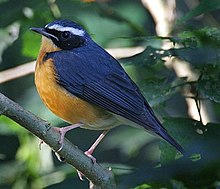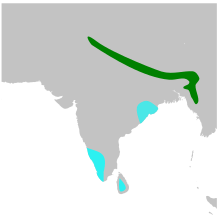Indian blue robin
| Indian blue robin | |
|---|---|
 |
|
| Male in winter | |
| Scientific classification | |
| Kingdom: | Animalia |
| Phylum: | Chordata |
| Class: | Aves |
| Order: | Passeriformes |
| Family: | Muscicapidae |
| Genus: | Larvivora |
| Species: | L. brunnea |
| Binomial name | |
|
Larvivora brunnea Hodgson, 1837 |
|
 |
|
| Breeding area in green and wintering areas in blue | |
| Synonyms | |
|
Erithacus brunneus |
|
Erithacus brunneus
Larvivora brunnea
Tarsiger brunnea
Larvivora wickhami
Luscinia brunnea
The Indian blue robin (Larvivora brunnea) is a small bird found in South Asia. Formerly considered a thrush, it is now considered one of the Old World flycatchers in the family Muscicapidae. It was earlier also called the Indian blue chat. It is migratory, breeding in the forests along the Himalayas of Nepal, India and Myanmar. They winter in the hill forests of the Western Ghats of India and in Sri Lanka.
The Indian blue robin was described by Hodgson who placed it in a new genus Larvivora but it was later placed in the genus Luscinia. A large-sample molecular phylogenetic study published in 2010 found that Luscinia was not monophyletic. The genus was therefore split and several species including Indian blue robin were moved to the reinstated genus Larvivora.Larvivora is a sister of the species Brachypteryx montana, Brachypteryx leucophrys and Brachypteryx hyperythra.
The Indian blue robin is similar in size to the related bluethroat at 15 cm long. The adult male has blue upperparts and rufous underparts. A bright white supercilium contrasts with a black mask that continues down the neck. The lower belly and undertail are also whitish. The female is olive brown above and buff below with a light eye-ring and rufescent rump. The breast and flanks are buffy.
...
Wikipedia

